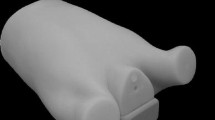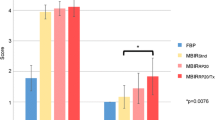Abstract
Objectives
To evaluate the image quality (IQ) of a spectral photon-counting CT (SPCCT) using filtered back projection (FBP) and hybrid iterative reconstruction (IR) algorithms (iDose4), in comparison with a dual-layer CT (DLCT) system, and to choose the best image quality according to the IR level for SPCCT.
Methods
Two phantoms were scanned using a standard lung protocol (120 kVp, 40 mAs) with SPCCT and DLCT systems. Raw data were reconstructed using FBP and 9 iDose4 levels (i1/i2/i3/i4/i5/i6/i7/i9/i11) for SPCCT and 7 for DLCT (i1/i2/i3/i4/i5/i6/i7). Noise power spectrum and task-based transfer function (TTF) were computed. Detectability index (d′) was computed for detection of 4 mm ground-glass nodule (GGN) and solid nodule. Two chest radiologists performed an IQ evaluation (noise/nodule sharpness/nodule conspicuity/overall IQ) in consensus, and chose the best image for SPCCT.
Results
Noise magnitude was −47% ± 2% lower on average with SPCCT than with DLCT for iDose4 range from i1 to i6. Average NPS spatial frequencies increased for SPCCT in comparison with DLCT. TTF also increased, except for the air insert with FBP, and i1/i2/i3. Higher detectability was found for SPCCT for both GGN and solid nodules. IQ for both types of nodule was rated consistently higher with SPCCT than with DLCT for the same iDose4 level. For SPCCT and both nodules, the scores for noise and conspicuity improved with increasing iDose4 level. iDose4 level 6 provided the best subjective IQ for both types of nodule.
Conclusions
Higher IQ for GGN and solid nodules was demonstrated with SPCCT compared with DLCT with better detectability using iDose4.
Key Points
-
Using spectral photon-counting CT compared with dual-layer CT, noise magnitude was reduced with improvements in spatial resolution and detectability of ground-glass nodules and solid lung nodules.
-
As the iDose 4 level increased, noise magnitude was reduced and detectability of ground-glass and solid lung nodules was better for both CT systems.
-
For spectral photon-counting CT imaging, two chest radiologists determined iDose 4 level 6 as the best image quality for detecting ground-glass nodules and solid lung nodules.





Similar content being viewed by others
Abbreviations
- DLCT:
-
Dual-layer computed tomography
- ESF:
-
Edge spread function
- FBP:
-
Filtered back projection
- FOV:
-
Field-of-view
- GGN:
-
Ground-glass nodule
- iDose4 :
-
Intelligent dose
- IR:
-
Iterative reconstruction
- LSF:
-
Line spread function
- NPS:
-
Noise power spectrum
- NPWE:
-
Nonprewhitening model observer with eye filter
- SPCCT:
-
Spectral photon-counting computed tomography
- TTF:
-
Task-based transfer function
References
de Koning HJ, van der Aalst CM, de Jong PA et al (2020) Reduced lung-cancer mortality with volume CT screening in a randomized trial. N Engl J Med 382:503–513. https://doi.org/10.1056/NEJMoa1911793
National Lung Screening Trial Research Team, Aberle DR, Adams AM et al (2011) Reduced lung-cancer mortality with low-dose computed tomographic screening. N Engl J Med 365:395–409. https://doi.org/10.1056/NEJMoa1102873
Si-Mohamed S, Boussel L, Douek P (2020) Clinical applications of spectral photon-counting CT. In: Spectral, photon counting computed tomography: technology and applications, CRC Press. pp 97–116
Si-Mohamed S, Bar-Ness D, Sigovan M et al (2017) Review of an initial experience with an experimental spectral photon-counting computed tomography system. Nucl Inst Methods Phys Res B 873:27–35. https://doi.org/10.1016/j.nima.2017.04.014
Taguchi K, Iwanczyk JS (2013) Vision 20/20: Single photon counting x-ray detectors in medical imaging. Med Phys 40:100901. https://doi.org/10.1118/1.4820371
Kopp FK, Daerr H, Si-Mohamed S et al (2018) Evaluation of a preclinical photon-counting CT prototype for pulmonary imaging. Sci Rep 8:17386. https://doi.org/10.1038/s41598-018-35888-1
Sigovan M, Si-Mohamed S, Bar-Ness D et al (2019) Feasibility of improving vascular imaging in the presence of metallic stents using spectral photon counting CT and K-edge imaging. Sci Rep 9:19850. https://doi.org/10.1038/s41598-019-56427-6
Si-Mohamed S, Thivolet A, Bonnot P-E et al (2018) Improved peritoneal cavity and abdominal organ imaging using a biphasic contrast agent protocol and spectral photon counting computed tomography K-edge imaging. Invest Radiol 53:629–639. https://doi.org/10.1097/RLI.0000000000000483
Blevis I (2020) X-Ray detectors for spectral photon-counting CT. In: Spectral, photon counting computed tomography: technology and applications, CRC Press. pp 179–191
Hsieh (2020) Design considerations for photon-counting detectors: connecting detectors characteristics to system performances. In: Spectral, photon counting computed tomography: technology and applications, CRC Press. pp 326–341
Bartlett DJ, Koo CW, Bartholmai BJ et al (2019) High-resolution chest computed tomography imaging of the lungs: impact of 1024 matrix reconstruction and photon-counting detector computed tomography. Invest Radiol 54:129–137. https://doi.org/10.1097/RLI.0000000000000524
Si-Mohamed S, Boccalini S, Rodesch P-A et al (2021) Feasibility of lung imaging with a large field-of-view spectral photon-counting CT system. Diagn Interv Imaging. https://doi.org/10.1016/j.diii.2021.01.001
da Silva J, Grönberg F, Cederström B et al (2019) Resolution characterization of a silicon-based, photon-counting computed tomography prototype capable of patient scanning. J Med Imaging (Bellingham) 6, 043502. https://doi.org/10.1117/1.JMI.6.4.043502
Boccalini S, Si-Mohamed S, Dessouky R, Sigovan M, Boussel L, Douek P. (2021) Feasibility of human vascular imaging of the neck with a large field-of-view spectral photon-counting CT system. Diagn Interv Imaging. https://doi.org/10.1016/j.diii.2020.12.004
Ferda J, Vendiš T, Flohr T et al (2021) Computed tomography with a full FOV photon-counting detector in a clinical setting, the first experience. Eur J Radiol 137:109614. https://doi.org/10.1016/j.ejrad.2021.109614
Greffier J, Fernandez A, Macri F, Freitag C, Metge L, Beregi JP (2013) Which dose for what image? Iterative reconstruction for CT scan. Diagn Interv Imaging 94:1117–1121. https://doi.org/10.1016/j.diii.2013.03.008
Greffier J, Frandon J, Larbi A, Beregi JP, Pereira F (2019) CT iterative reconstruction algorithms: a task-based image quality assessmen. Eur Radiol. https://doi.org/10.1007/s00330-019-06359-6
Samei E, Richard S (2015) Assessment of the dose reduction potential of a model-based iterative reconstruction algorithm using a task-based performance metrology. Med Phys 42:314–323. https://doi.org/10.1118/1.4903899
Verdun FR, Racine D, Ott JG et al (2015) Image quality in CT: from physical measurements to model observers. Phys Med 31:823–843. https://doi.org/10.1016/j.ejmp.2015.08.007
Greffier J, Boccalini S, Beregi JP et al (2020) CT dose optimization for the detection of pulmonary arteriovenous malformation (PAVM): a phantom study. Diagn Interv Imaging. https://doi.org/10.1016/j.diii.2019.12.009
Rotzinger DC, Racine D, Beigelman-Aubry C et al (2018) Task-based model observer assessment of a partial model-based iterative reconstruction algorithm in thoracic oncologic multidetector CT. Sci Rep:8. https://doi.org/10.1038/s41598-018-36045-4
Greffier J, Frandon J, Pereira F et al (2020) Optimization of radiation dose for CT detection of lytic and sclerotic bone lesions: a phantom study. Eur Radiol 30:1075–1078. https://doi.org/10.1007/s00330-019-06425-z
American College of Radiology (2015) Lung CT screening reporting and data system lung-RADS). https://www.acr.org/Clinical-Resources/Reporting-and-Data-Systems/Lung-Rads.
Steadman R, Herrmann C, Livne A (2017) ChromAIX2: a large area, high count-rate energy-resolving photon counting ASIC for a spectral CT prototype. Nucl Inst Methods Phys Res B 862:18–24. https://doi.org/10.1016/j.nima.2017.05.010
Greffier J, Larbi A, Frandon J et al (2019) Comparison of noise-magnitude and noise-texture across two generations of iterative reconstruction algorithms from three manufacturers. Diagn Interv Imaging 100:401–410. https://doi.org/10.1016/j.diii.2019.04.006
Greffier J, Si-Mohamed S, Dabli D et al (2021) Performance of four dual-energy CT platforms for abdominal imaging: a task-based image quality assessment based on phantom data. Eur Radiol. https://doi.org/10.1007/s00330-020-07671-2
Acknowledgements
We are deeply grateful to J. Solomon for support regarding the use of imQuest software.
We also thank Teresa Sawyers, Medical Writer, at the BESPIM, Nîmes University Hospital, France, for her help in editing the manuscript.
Funding
This work was supported by European Union Horizon 2020 grant No 643694.
Author information
Authors and Affiliations
Corresponding author
Ethics declarations
Guarantor
The scientific guarantor of this publication is Pr. Philippe DOUEK.
Conflict of interest
Yoad Yagil, Philippe Coulon, Alain Vlassenbroek declare relationships with the following companies: Philips Healthcare.
Statistics and biometry
No complex statistical methods were necessary for this paper.
Informed consent
Not applicable.
Ethical approval
Not applicable.
Methodology
• Comparative phantom study.
Additional information
Publisher’s note
Springer Nature remains neutral with regard to jurisdictional claims in published maps and institutional affiliations.
Rights and permissions
About this article
Cite this article
Si-Mohamed, S.A., Greffier, J., Miailhes, J. et al. Comparison of image quality between spectral photon-counting CT and dual-layer CT for the evaluation of lung nodules: a phantom study. Eur Radiol 32, 524–532 (2022). https://doi.org/10.1007/s00330-021-08103-5
Received:
Revised:
Accepted:
Published:
Issue Date:
DOI: https://doi.org/10.1007/s00330-021-08103-5




